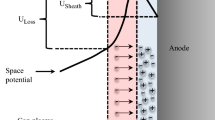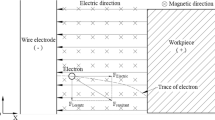Abstract
Due to the non-isoenergetic nature of discharge pulses in resistance-capacitance (RC) based micro electrical discharge machining (μEDM), the volume of produced micro-crater by each pulse varies significantly. This fact has driven the researchers in this work to propose an electrothermal principle–based analytical model to approximate dimensional accuracies of such micro-craters. A finite element (FE) simulation considering Gaussian heat flux distribution of single discharge μEDM has been performed at significant input parameters such as discharge energy, capacitance, and open-circuit voltage and compared with analytical simulation results. Upon validation of these simulated results with experimental results, nominal dimensional inaccuracies of 2–11% for a wide range of input parameters have been noticed. This effectively predicted crater dimension from the workpiece can be incorporated in the proposed thermal modeling–based real-time tool wear monitoring and compensation system through a unique strategy, which is discussed at the end.



















Similar content being viewed by others
Abbreviations
- μEDM:
-
Micro electrical discharge machining
- CFD:
-
Computational fluid dynamics
- DAQ:
-
Data acquisition card
- EDS:
-
Energy dispersive spectroscopy
- FE:
-
Finite element
- FD:
-
Finite difference
- MRR:
-
Material removal rate
- PD:
-
Pulse discrimination
- SR:
-
Surface roughness
- SEM:
-
Scanning electron microscopy
- TWR:
-
Tool wear rate
- V MR :
-
Actual volume removal
- V target :
-
Target volume
- VRD:
-
Volume removal per discharge
- c p :
-
Average specific heat (Jkg−1K−1.)
- C :
-
Combination of fraction energy and a fraction of molten area (Dimensionless)
- erfc :
-
Complementary error function (Dimensionless)
- E P :
-
Energy of each pulse (μJ)
- E :
-
Complete elliptic integrals of the second kind (Dimensionless)
- h c :
-
Convective heat transfer coefficient (Wm−2K)
- I a :
-
Average current (A)
- J 0 :
-
Bessel function of the first kind of zero-order (Dimensionless)
- J 1 :
-
Bessel function of the first kind of first-order (Dimensionless)
- K t :
-
Thermal conductivity of the material (Wm−1K−1)
- K :
-
Complete elliptic integrals of the first kind (Dimensionless)
- L m :
-
Latent heat of melting (kJ/kg)
- L V :
-
Latent heat of vaporization (kJ/kg)
- N p :
-
Number of actual contributing pulses (Dimensionless)
- q :
-
Heat flux (Wm−2)
- R a :
-
Heat flux radius at anode (μm)
- r :
-
Radial coordinates (μm)
- R :
-
Heat flux radius (μm)
- t :
-
Time in seconds (s)
- T :
-
Temperature (K)
- T s :
-
Solidus temperature (K)
- T l :
-
Liquids temperature (K)
- T 0 :
-
Ambient temperature (K)
- t on :
-
Pulse on time (μs)
- u :
-
Dimensionless radius (Dimensionless)
- V a :
-
Average voltage (V)
- V 0 :
-
Open circuit voltage (V)
- α :
-
Thermal diffusivity of material (m2s−1)
- λ :
-
Dummy variables (Dimensionless)
- ρ :
-
Density of material (kgm−3)
- θ :
-
Ratio of anode erosion rate (Dimensionless)
- τ :
-
Dimensionless time (Dimensionless)
- w :
-
Dimensionless depth (Dimensionless)
- z :
-
Depth or axial coordinates (μm)
References
Kaminski PC, Capuano MN (2003) Micro hole machining by conventional penetration electrical discharge machine. Int J Mach Tools Manuf 43:1143–1149. https://doi.org/10.1016/S0890-6955(03)00124-X
Diver C, Atkinson J, Helml HJ, Li L (2004) Micro-EDM drilling of tapered holes for industrial applications. J Mater Process Technol 149:296–303. https://doi.org/10.1016/j.jmatprotec.2003.10.064
Ho KH, Newman ST, Rahimifard S, Allen RD (2004) State of the art in wire electrical discharge machining (WEDM). Int J Mach Tools Manuf 43:287–300. https://doi.org/10.1016/j.ijmachtools.2004.04.017
Nadda R, Nirala CK, Saha P (2019) Tool wear compensation in micro-EDM. In: Kibria G, Jahan M, Bhattacharyya B (eds) Micro-electrical discharge machining processes. Materials forming, machining and tribology. Springer, Singapore, pp 185–208. https://doi.org/10.1007/978-981-13-3074-2_9
Nirala CK, Saha P (2016) Evaluation of μEDM-drilling and μEDM-dressing performances based on online monitoring of discharge gap conditions. Int J Adv Manuf Technol 85:1995–2012. https://doi.org/10.1007/s00170-015-7934-0
Messler RW (2011) Overview of welding processes. Weld Fundam Process ASM Handb 6:13–26
Asad ABMA, Islam MT, Masaki T, Rahman M, Wong YS (2018) Analysis of micro-EDM electric characteristics employing plasma property. CIRP J Manuf Sci Technol 20:36–50. https://doi.org/10.1016/j.cirpj.2017.09.005
Nirala CK, Saha P (2017) Precise μEDM-drilling using real-time indirect tool wear compensation. J Mater Process Technol 240:176–189. https://doi.org/10.1016/j.jmatprotec.2016.09.024
Jung JW, Jeong YH, Min BK, Lee SJ (2008) Model-based pulse frequency control for micro-EDM milling using real-time discharge pulse monitoring. J Manuf Sci Eng 130:31106-1–31106-3110611. https://doi.org/10.1115/1.2917305
Bissacco G, Valentincic J, Hansen HN, Wiwe BD (2010) Towards the effective tool wear control in micro-EDM milling. Int J Adv Manuf Technol 68:179–182. https://doi.org/10.1007/s00170-009-2057-0
Bleys P, Kruth JP, Lauwers B, Zryd A, Delpretti R, Tricarico C (2002) Real-time tool wear compensation in milling EDM. CIRP Ann - Manuf Technol 51:157–160. https://doi.org/10.1016/S0007-8506(07)61489-9
Narasimhan J, Yu Z, Rajurkar KP (2005) Tool wear compensation and path generation in micro and macro EDM. J Manuf Process 7:75–82. https://doi.org/10.1016/S1526-6125(05)70084-0
Yan MT, Huang KY, Lo CY (2009) A study on electrode wear sensing and compensation in micro-EDM using machine vision system. Int J Adv Manuf Technol 42:1065–1073. https://doi.org/10.1007/s00170-008-1674-3
Aligiri E, Yeo SH, Tan PC (2010) A new tool wear compensation method based on real-time estimation of material removal volume in micro-EDM. J Mater Process Technol 210:2292–2303. https://doi.org/10.1016/j.jmatprotec.2010.08.024
Nadda R, Nirala CK (2019) Effect of single spark micro-EDM on crater size of different alloys. IOP Conf Ser Mater Sci Eng 561:012032. https://doi.org/10.1088/1757-899X/561/1/012032
Chu X, Feng W, Wang C, Hong Y (2017) Analysis of mechanism based on two types of pulse generators in micro-EDM using single pulse discharge. Int J Adv Manuf Technol 89:3217–3230. https://doi.org/10.1007/s00170-016-9287-8
Sarikavak Y, Cogun C (2012) Single discharge thermo-electrical modeling of micromachining mechanism in electric discharge machining. J Mech Sci Technol 26:1591–1597. https://doi.org/10.1007/s12206-012-0305-y
Snoeys R, Dijck FSV (1971) Investigation of electro discharge machining operations by means of a thermo-mathematical model. CIRP Ann 20:35–37
Dijck VFS, Dutré WL (1974) Heat conduction model for the calculation of the volume of molten metal in electric discharges. J Phys D Appl Phys 7:899–910. https://doi.org/10.1088/0022-3727/7/6/316
Eubank PT, Patel MR, Barrufet MA, Bozkurt B (1993) Theoretical models of the electrical discharge machining process. III. The variable mass, cylindrical plasma model. J Appl Phys 73:7900–7909. https://doi.org/10.1063/1.353942
Dhanik S, Joshi SS (2005) Modelling of a single resistance capacitance pulse discharge in micro-electro discharge machining. J Manuf Sci Eng Trans ASME 127:759–767. https://doi.org/10.1115/1.2034512
Hoang KT, Gopalan SK, Yang SH (2015) Study of energy distribution to electrodes in a micro-EDM process by utilizing the electro-thermal model of single discharges. J Mech Sci Technol 29:349–356. https://doi.org/10.1007/s12206-014-1241-9
Wang K, Zhang Q, Zhu G, Liu Q, Huang Y, Zhang J (2017) Research on the energy distribution of micro EDM by utilization of electro-thermal model. Int J Adv Manuf Technol 93:4179–4186. https://doi.org/10.1007/s00170-017-0822-z
Ming W, Zhang Z, Wang S, Zhang Y, Shen F, Zhang G (2019) Comparative study of energy efficiency and environmental impact in magnetic field assisted and conventional electrical discharge machining. J Clean Prod 214:12–28. https://doi.org/10.1016/j.jclepro.2018.12.231
Beck JV (1981) Large time solutions for temperatures in a semi-infinite body with a disk heat source. Int J Heat Mass Transf 24:155–164. https://doi.org/10.1016/0017-9310(81)90104-6
Pandey PC, Jilani ST (1986) Plasma channel growth and the resolidified layer in EDM. Precis Eng 8:104–110. https://doi.org/10.1016/0141-6359(86)90093-0
Shahri HRF, Mahdavinejad R, Ashjaee M, Abdullah A (2017) A comparative investigation on temperature distribution in electric discharge machining process through analytical, numerical and experimental methods. Int J Mach Tools Manuf 114:35–53. https://doi.org/10.1016/j.ijmachtools.2016.12.005
Gostimirovic M, Radovanovic M, Madic M, Rodic D, Kulundzic N (2018) Inverse electro-thermal analysis of the material removal mechanism in electrical discharge machining. Int J Adv Manuf Technol 97:1861–1871. https://doi.org/10.1007/s00170-018-2074-y
Das S, Klotz M, Klocke F (2003) EDM simulation: finite element-based calculation of deformation, microstructure and residual stresses. J Mater Process Technol 142:434–451. https://doi.org/10.1016/S0924-0136(03)00624-1
Marafona J, Chousal JAG (2006) A finite element model of EDM based on the joule effect. Int J Mach Tools Manuf 46:595–602. https://doi.org/10.1016/j.ijmachtools.2005.07.017
Joshi SN, Pande SS (2010) Thermo-physical modelling of die-sinking EDM process. J Manuf Process 12:45–56. https://doi.org/10.1016/j.jmapro.2010.02.001
Kalajahi MH, Ahmadi SR, Oliaei SNB (2013) Experimental and finite element analysis of EDM process and investigation of material removal rate by response surface methodology. Int J Adv Manuf Technol 69:687–704. https://doi.org/10.1007/s00170-013-5059-x
Muralidharan B, Chelladurai H, Singh P, Roy MK (2016) Single-spark analysis of electro-discharge deposition process. Mater Manuf Process 31:1853–1864. https://doi.org/10.1080/10426914.2015.1127936
Kuriachen B, Mathew J (2016) Spark radius modelling of resistance-capacitance pulse discharge in micro-electric discharge machining of Ti-6Al-4V: an experimental study. Int J Adv Manuf Technol 85:1983–1993. https://doi.org/10.1007/s00170-015-7999-9
Klocke F, Mohammadnejad M, Zeis M, Klink A (2018) Investigation on the variability of existing models for simulation of local temperature field during a single discharge for electrical discharge machining (EDM). Procedia CIRP 68:260–265. https://doi.org/10.1016/j.procir.2017.12.059
Assarzadeh S, Ghoreishi M (2017) Electro-thermal-based finite element simulation and experimental validation of material removal in static gap single spark die-sinking electro-discharge machining process. Proc Inst Mech Eng Part B J Eng Manuf 231:28–47. https://doi.org/10.1177/0954405415572661
Das S, Paul S, Doloi B (2019) Application of CFD and vapor bubble dynamics for an efficient electro-thermal simulation of EDM: an integrated approach. Int J Adv Manuf Technol 102:1787–1800. https://doi.org/10.1007/s00170-018-3144-x
Shobert EI (1983) What happens in EDM electrical discharge machining: tooling, methods, and applications. Society of Manufacturing Engineers, Dearborn, MI, pp 3–4
Yeo SH, Kurnia W, Tan PC (2007) Electro-thermal modelling of anode and cathode in micro-EDM. J Phys D Appl Phys 40:2513–2521. https://doi.org/10.1088/0022-3727/40/8/015
Patel MR, Barrufet MA, Eubank PT, DiBitonto DD (1989) Theoretical models of the electrical discharge machining process. II. The anode erosion model. J Appl Phys 6964104-11. https://doi.org/10.1063/1.343995
Carslaw HS, Jaeger JC Conduction of heat in solids. Clarendon, Oxford
Thomas PH (1957) Some conduction problems in the heating of small areas on large solids. Q J Mech Appl Math 10:482–493. https://doi.org/10.1093/qjmam/10.4.482
Valencia JJ, Quested PN (2008) Thermophysical properties. ASM Handb Cast 15:468–481
Shao B, Rajurkar KP (2015) Modelling of the crater formation in micro-EDM. Procedia CIRP 33:376–381. https://doi.org/10.1016/j.procir.2015.06.085
Funding
The authors received financial support from the Department of Science and Technology (DST) Govt. of India (Grant No. ECR/DST/2017/000918)
Author information
Authors and Affiliations
Corresponding author
Additional information
Publisher’s note
Springer Nature remains neutral with regard to jurisdictional claims in published maps and institutional affiliations.
Rights and permissions
About this article
Cite this article
Nadda, R., Nirala, C.K. Thermal modeling of single discharge in prospect of tool wear compensation in μEDM. Int J Adv Manuf Technol 107, 4573–4595 (2020). https://doi.org/10.1007/s00170-020-05238-5
Received:
Accepted:
Published:
Issue Date:
DOI: https://doi.org/10.1007/s00170-020-05238-5




